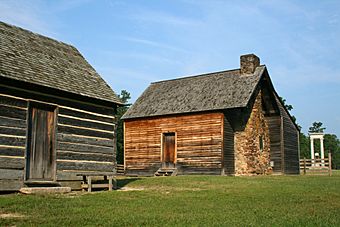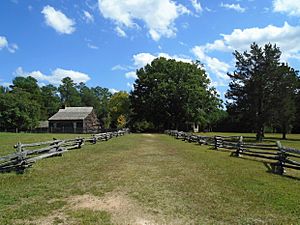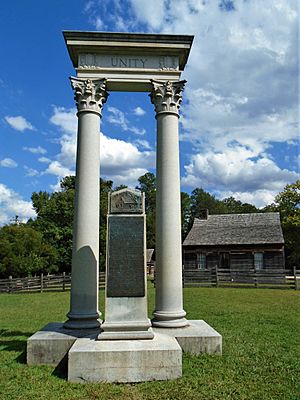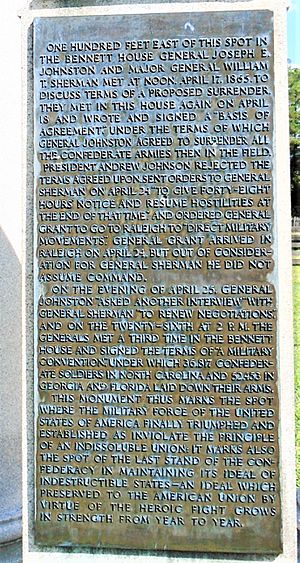Bennett Place facts for kids
Quick facts for kids |
|
|
Bennett Place State Historic Site
|
|
 |
|
| Location | 4409 Bennett Memorial Rd., Durham, North Carolina |
|---|---|
| Area | 30.5 acres (12.3 ha) |
| Built | 1789 |
| NRHP reference No. | 70000452 |
| Added to NRHP | February 26, 1970 |
Bennett Place is a historic farm in Durham, North Carolina. It was the place where a very important event happened during the American Civil War. Here, on April 26, 1865, Confederate General Joseph E. Johnston surrendered his large army to Union General William T. Sherman. This surrender was a huge step in ending the Civil War.
The first meeting between the generals happened on April 17, 1865. General Sherman agreed to some political requests from the Confederates. However, the Union government in Washington quickly said no to these terms. So, another meeting was needed on April 26. This time, they only agreed on military terms, similar to how General Robert E. Lee had recently surrendered to General Ulysses S. Grant. This final agreement at Bennett Place helped bring the war to an end.
Contents
The End of the Civil War: A Historic Meeting
After General William Tecumseh Sherman's famous "March to the Sea" through Georgia, he moved his army north into the Carolinas. Meanwhile, Confederate President Jefferson Davis met with his General Joseph E. Johnston in Greensboro, North Carolina. General Sherman's army had stopped in Raleigh.
On April 9, 1865, General Robert E. Lee's main Confederate army surrendered to General Ulysses S. Grant at Appomattox Court House. Even though President Davis wanted to keep fighting, General Johnston sent a message to General Sherman. He offered to meet to discuss a truce. Johnston's army was still strong, and they had a way to retreat with supplies.
General Johnston, with about 60 cavalry soldiers, rode east towards Durham Station. General Sherman, with 200 cavalry soldiers, rode west to meet him. The farm of James and Nancy Bennett, known as Bennett Place, was a quiet and private spot for their meeting.
First Meeting and Lincoln's Assassination
The first discussion took place on April 17. During this meeting, General Sherman shared shocking news with Johnston: President Abraham Lincoln had been assassinated. The generals met again the next day, April 18, and signed surrender terms.
However, on April 24, General Grant arrived and told Sherman that the government in Washington had rejected the terms. The reason was that Sherman's terms included political matters, which went beyond what Grant had offered Lee.
Final Surrender Agreement
The generals met one more time on April 26, 1865. With help from General John M. Schofield, they agreed to new terms. These new terms focused only on military matters. This agreement officially disbanded all active Confederate forces in North Carolina, South Carolina, Georgia, and Florida. This included 89,270 soldiers, making it the largest group to surrender during the entire Civil War.
Why the Surrender Was Difficult
Reaching a surrender agreement was tricky. General Johnston, influenced by President Davis, wanted more than just a military surrender. General Sherman's first offer was similar to what General Grant gave Lee. However, Johnston, along with General John C. Breckinridge (who was also the Confederate Secretary of War), wanted to discuss political issues. These included how state governments would be set up again and what civil rights soldiers would have after the war.
Sherman, following what he believed were Lincoln's wishes for a kind end to the war, agreed to terms that included these political points. But Sherman didn't know that Lincoln had told Grant to only discuss military matters with Lee.
Terms Rejected by Washington
After reviewing Sherman's first surrender terms, United States Secretary of War Edwin M. Stanton convinced the government cabinet to reject them. Sherman was then told to meet Johnston again and ask for a purely military surrender. President Davis ordered Johnston to break up his army and escape with his cavalry. However, Johnston chose to disobey these orders and met with General Sherman again at Bennett Farm.
The second negotiation happened on April 26, 1865. The generals agreed to new military surrender terms. These terms were almost the same as those Grant had given to Lee. They also included details about food and how the soldiers would return home. This surrender agreement ended the war for nearly 90,000 soldiers in the Southeast. A few more smaller surrenders followed in other places.
Bennett Place State Historic Site Today
James and Nancy Bennett, who owned the farm where the meetings took place, were simple farmers. They suffered greatly during the four years of the war. They lost a son, Lorenzo, and their daughter Eliza's husband, Robert Duke, both of whom died serving the Confederacy. Their third child, Alfonzo, also passed away during the war years in 1864. The Bennetts never fully recovered from the war. In 1878, James Bennett died, and his family moved to the new town of Durham.
The farm was left empty and slowly fell apart. A fire finally destroyed the farmhouse in 1921. In 1923, the Unity Monument was placed at the site to remember the peace that began there. Many people helped save this important landmark.
In 1960, the site was fully restored by local groups. The farmhouse was rebuilt as a two-story log building with a roof and an addition. A log kitchen and a smokehouse were also rebuilt on the property. The site was then given to the State of North Carolina and became a state historic site.
The Bennett Place State Historic Site is now managed by the North Carolina Department of Natural and Cultural Resources. It is located in western Durham, close to Duke University. The site is open to the public from Tuesday to Saturday, 9 AM to 5 PM. Visitors can explore a visitor center, a museum, and watch a film called "Dawn of Peace." There is also a gift shop and a reconstruction of the Bennett farm. Throughout the year, the site hosts special events, including living history programs and commemorations of the surrender. It was added to the National Register of Historic Places in 1970.
On April 15, 2010, the Bennett Place Historic Site revealed a new painting by Civil War artist Dan Nance, called "The First Meeting." On the same day, the site started the William Vatavuk Scholarship. This scholarship helps students who want to study history in college. It honors William Vatavuk, who wrote "Dawn of Peace," the first guidebook for the historic site.







